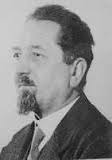Prominent Poles
Rudolf Stefan Weigl biologist and inventor of the first effective vaccine against epidemic typhus.

Born: September 2, 1883, Prerau, Austro-Hungarian Empire (presently Prerov, Czech Republic)
Died: August 11, 1957, in Zakopane, Poland
Early days. Weigl had Austrian heritage. His father died in a bicycle accident when he was a child. His mother, Elisabeth Kroesel, married a Polish high school teacher, Józef Trojnar, and they raised Weigl in Jasło, Poland. Later the family moved to Lemberg (originally Lwow, Poland and presently Lviv, Ukraine), where Weigl graduated in 1907 from the biology department at University of Jan Kazimierz, taught by professors Dybowski and Nusbaum-Hilarowicz . After graduation, Weigl became Nusbaum's assistant there and was habilitated in 1913 in the comparative zoology and anatomy department.
Career. He founded the Weigl Institute in Lwów, Poland (now Lviv, Ukraine), where he undertook vaccine research. It was there, during the Holocaust, that he harbored Jews and personally risked the death penalty to do so; his vaccines were also smuggled into the local ghetto as well as to the ghetto in Warsaw, saving countless additional Jewish lives.Following the Soviet and Nazi German invasions of Poland in World War II, Dr. Weigl's research attracted the attention of the Nazis. When they occupied Lwow they ordered him to set up a vaccine production plant at his Institute. About a thousand people worked there. Weigl employed and protected Polish intellectuals, Jews and members of the Polish underground. His vaccines were smuggled into ghettos in Lwow and Warsaw saving countless lives, until the Institute was shut down by the Soviet Union following anti-German offensive of 1944. Weigl moved to Kraków in 1945. He was appointed the Chair of General Microbiology Institute of the Jagiellonian University, and later as the Chair of Biology of the Medical Faculty in Poznań. Production of the vaccine remained in Kraków in the following years until discontinued.
Method of Vaccine Production. In 1930, following the 1909 discovery by Nicolle that lice were the vector of epidemic typhus and on the work for the vaccine for the closely related Rocky Mountain Spotted Fever, Weigl took the next step and developed a technique to produce the vaccine by growing infected lice and crushing them into a vaccine paste. He refined this technique over the years until 1933 when he performed large-scale testing. Growing lice meant feeding them blood, the more human the better. Around 1933 he commenced large-scale testing on humans, feeding the lice on human blood by letting them suck on human legs through a screen. This could cause typhus during the latter phase, when the lice were infected. He alleviated this problem by vaccinating the human "injectors" heavily, which successfully protected them from death (though some did develop the disease). Dr. Weigl himself developed the disease, but recovered. The first major application of this vaccine took place between 1936 and 1943 by the Belgian missionaries in China. The vaccine was dangerous to produce and was hard to make on a large scale. Other- more practical- vaccines were developed over time including the Cox vaccine developed from egg yolk.
Honors and awards. In 2003, professor Weigl was posthumously awarded the medal of Righteous Among the Nations of the World by the state of Israel. The Weigl Institute features prominently in Andrzej Żuławski's 1971 film The Third Part of the Night.
This article uses mostly material from the Wikipedia article "Rudolf Weigl":
Wikipedia
Text is available under the Creative Commons Attribution-ShareAlike License; additional terms may apply.
supplemented by information found in other sources
Waclaw Szybalski, "The genius of Rudolf Stefan Weigl...
Return to home page:
Prominent Poles
